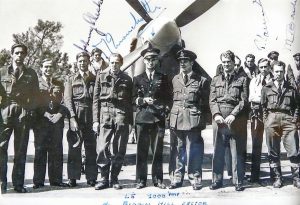Searching for René – Jan Leeming / Ian Reed
The research and commemoration of one of France’s greatest WWII fighter pilots and the RAF’s first French Squadron Leader.
My sincere thanks to the many people who were involved in this very special Anglo/French project: Jan, for setting us all off on this venture and the following for their support, research and hard work to make it happen: Lt. Col. Hubert De Lisle; Vladimir Trouplin; Georges-Didier Rohrbacher; Lucien Lafont; Air Commodore John Maas; Grp.Capt Mark Day; Sebastian Cox; Gillian Storey; Graham August; Col Pierre-Alain Antoine; Gen. Nicolas Chambaz; Lord Peter Ricketts; Gen Jean-Paul Palaméros; Air Commodore Tim Below; Grp Capt Antony McCord; AM Sir Stephen Dalton; HE Bernard Emié; Gen. Patrice Morand; AVM Sandy Hunter; Linda Bell (BBC); Ian Cundall (BBC/AirTV); Ministry of Defence; Pathé & ITV.
Ian Reed – 15 September 2021
Every July a commemoration takes place at The Battle of Britain Memorial overlooking the English Channel towards to coast of France, at Capel le Ferne near Dover. It is attended by many people and until very recently some of the last surviving pilots of the period. Jan Leeming, the former BBC TV presenter lives nearby and has been a big supporter of the Memorial for many years. She wanted to sponsor names on the Sir Chrisopher Foxley-Norris Memorial Wall at Capel. On the Wall are inscribed the names of just under 3000 pilots and aircrew who took part in the Battle (10th July – 31st October 1940). They came from France, Poland, Czechoslovakia, North and South Rhodesia (Zimbabwe today), Belgium, Ireland, Newfoundland, the USA, Canada, Australia and New Zealand and even one pilot from Jamaica.
Receiving the name of ‘her pilot’, Jan then typed it into an Internet search-engine and realized that a true adventure story was starting to unfold….. she had ‘adopted’ a French Hero – Commandant René Mouchotte RAF – recipient of the Croix de Guerre, the Legion d’Honneur, the DFC, and the first non British Commonwealth airman to become an RAF Squadron Leader. This then lead Jan on an expedition to learn about this dynamic and highly intelligent and respected French flier. It lead her to Belgium where his body had washed up in 1943; to Paris to discover his relatives and to York to learn about the French airmen who continued the fight to liberate their homeland from bases in Britain.
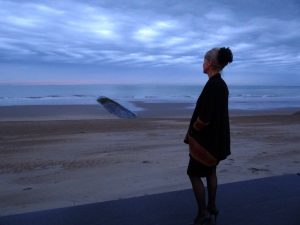
Jan Leeming gazes over the sea at Westende, near Middelkerke in Belgium, where Mouchotte’s body was washed up in August 1943.
René’s famous contemporary war diaries were never meant for publication, but ‘Les Carnets de René Mouchotte’ was eventually published in 1949 and translated into English in 1956. It was not written “after the event” as so many were, but was an actual daily account, not smoothed over or changed with the knowledge of hindsight. As such it provides a highly readable, emotive and often starkly truthful side to the actions of young fighter pilots in the Royal Air Force, up against enormous odds day in and day out.
Born on 21st August 1914 at St Mandé, Paris, his passion had always been aeroplanes and a picture of Georges Guynemer, the famous French WW1 fighter ace, adorned his bedroom at home. He learned to fly as a teenager and his mother bought him an aeroplane for his 18th birthday in 1932. He joined the Armée de l’Air for his National Service at Istres and by 1937 he was placed on the reserve list until war broke out in 1939, when he was recalled to train young pilots at Salon de Provence and Avord.
An estimated 65% of French fighter pilots were lost in the first 3 months of the war against the Luftwaffe. The German pilots had the advantage of modern aeroplanes and recent combat experience in Spain, and took a huge toll on the French and British airmen.
René’s training unit was withdrawn to Algeria but on the way he and 5 friends applied to be “fighter pilots”. Shortly after arrival in Oran, the French Government capitulated to the Germans on 22nd June 1940, with an armistice giving subjugated power to Marshal Pétain’s government based in Vichy.
Severe punishment, even death, threatened anyone who went on to fight for or join the British, and the planes at Oran were immobilised to prevent escape. On 30th June 1940, Mouchotte and 5 friends including a very young pilot named Henry Lafont, escaped to Gibraltar by stealing the station commander’s twin Renault engined Caudron Goéland. The sudden escape was almost a disaster when, having hidden in the aircraft all night, on starting the engine at sunrise they found the propeller pitch control had been disabled, reducing power considerably for take-off. Narrowly missing the boundary fencing and avoiding chasing fighters they hopped over the waves of the Mediterranean and disappeared into the mists towards Gibraltar, with nothing more than a road map and a compass to guide them.

René Mouchotte (R) with Charles Guerin (L) at the controls of the Caudron Goéland during their escape on 30th June 1940.
With reports that the British would either shoot them down or repatriate them to severe punishment in France or that the Spanish would shoot them down if they veered over the nearby mainland they believed their chances were slim, but were overjoyed by the reception they eventually received by the “Tommies” as they landed in Gibraltar. They were feted by the British who sang “Le Marseillais” as they paraded through the town and were eventually shipped off to Britain arriving at Liverpool on 13th July where they all joined the RAF, which was very soon to face its greatest test in the Battle of Britain.
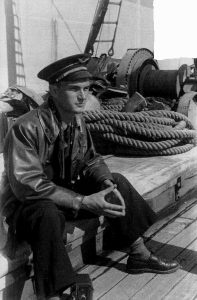
René Mouchotte aboard the armed merchant ship, “President Houdouce”, en route to Liverpool, July 1940.

The “President Houdouce”
His fighter aircraft training began immediately in Wales, Wiltshire and Lincolnshire. He joined 245 Squadron in Northern Ireland, and was then promoted and posted to 615 Squadron. This squadron had fought in the Battle of France and at Dunkirk, and flew Hawker Hurricanes, which were the most numerous British fighter during the Battle of Britain and accounted for 60% of Luftwaffe losses.
At RAF Northolt, and RAF Kenley near London, he flew daily missions against Luftwaffe attacks and on 26th August 1941 he destroyed a Junkers Ju88 fighter-bomber and began regular attacks on German targets in the Pas de Calais.
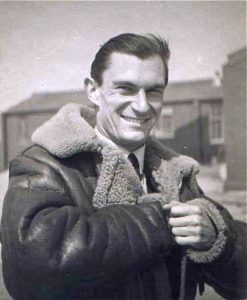
In 1941, he was posted to the first Free French Squadron at RAF Turnhouse in Scotland (now Edinburgh Airport). 340 Squadron had Spitfires bearing the Cross of Lorraine and were now part of Le Groupe de Chasse IV/2 “Ile de France” (later to become Escadron de Chasse 02.005). René took command of “A” Flight (“Paris”) and on “Bastille Day”, 14th July, General De Gaulle presented him with the Croix de Guerre with Palme.

RAF Old Sarum, Wiltshire – 1940
Mouchotte (kneeling) with the French pilots who flew during the Battle of Britain. Eventually all of these pilots, except just 3, were killed in action.
On 1st September 1942, Squadron Leader (Cmndt), René Mouchotte took command of the high scoring 65 Squadron RAF and became the first non-British Commonwealth airman to lead a RAF Fighter Squadron. He was also awarded the Distinguished Flying Cross (DFC).

Mouchotte’s flying Log Book contains many cartoon images which he drew
In January 1943, he was given the command of 341 Squadron (Groupe de Chasse n° 3/2 “Alsace”) which moved to the famous RAF Station at Biggin Hill in the south east of England, and on 15th May 1943, Squadron Leader ‘Jack’ Charles (611 Squadron) and René Mouchotte simultaneously destroyed two Focke Wolfe 190’s of I./JG 2., as the Biggin Hill Wing’s 999th and 1,000th kill.
The 1000th enemy aeroplane was a significant prize. It was agreed to “share” the honour and a famous party was held at the Grosvenor House Hotel in Central London to celebrate. The airmen had pooled their ration cards and Supermarine (the builder of the Spitfire) paid to provide the food. Around 2000 people attended including many celebrities and politicians, French, British and American. The London “cabbies” gave free rides for the airmen from Biggin Hill and also attended the event.
The occasion of the shooting down of the 1000th enemy aircraft over Britain. Mouchotte with “Sailor” Malan flanked by Jack Charles an Al Deere.
This bright spot was an all too brief respite in the daily life and death struggle in the skies above Britain and Northern France, whilst the War continued and the attacks continued. The Luftwaffe had, in no way, given up, and with the Allied successes in North Africa and Italy the pressure was on the RAF to pave the way for an invasion of Northern Europe. Intelligence had shown huge new concrete structures being built for the Atlantic Wall but also for new unmanned weapons which would eventually be released upon London.
On 27 August 1943, with Clostermann as his wingman, he led his squadron to escort USAF bombers on Operation Ramrod S.8 – the first daylight raid on what was to be recognised as the V2 rocket site in the Pas de Calais. They were attacked by large numbers of Luftwaffe fighters and Mouchotte’s wingman left his post. Rene’s last words were: “I am alone with the bombers”, and he was never heard from again. The loss to the squadron of this charismatic and expert tactician was immense. René Mouchotte had flown 1,748 hours and 382 missions in just 3 years.

Still wearing his flying kit, and totally exhausted, René Mouchotte takes a quick nap between sorties at RAF Biggin Hill
His body was washed ashore at Middelkerke in Belgium and being unidentified was interred in the local cemetery in Grave 87 . In 1949 an RAF Officer searched for him and Mouchotte was correctly identified and repatriated to France where he was reburied following a state funeral service with full military honours at Les Invalides in Paris.

René Mouchotte – his last picture 27.08.1943
His prophetic words written in his diaries in 1940 were ultimately to become his epitaph and said everything about a man whom both the Armée de l’Air and the Royal Air Force were proud to have had in their ranks, and for the people of Europe to be grateful for his sacrifice.
‘If Fate allows me only a brief fighting career, I shall thank Heaven for having been able to give my life for the liberation of France. Let my mother be told that I have always been very happy and thankful that the opportunity has been given me to serve GOD, MY COUNTRY AND THOSE I LOVE, and, that, whatever happens, I shall always be near her.’
René Mouchotte
July 1940.
BUT….the story does not end there……….
Enthralled by this tale of the airman, whose name she had sponsored, Jan Leeming began a search which would involve many others, to find out more about this charismatic young man whose spirit seemed to live on in his words and with those who knew him.
Jan travelled to Paris and at the corner of Avenue de la Chapelle in Cimetière Père Lachaise where notables such as Chopin, Edith Piaf, Oscar Wilde and even Van Morrison are buried, stands a well-kept tomb with a large bronze coloured Cross of Lorraine in the centre of its iron gates. Inside is a small photograph of a confident young airman, complete with Mae West life jacket – the last resting-place of René Mouchotte.
The Mouchotte Family tomb at the cemetery of Père Lachaise in Paris
Jan left a message in the tomb to see if any relatives of René were still alive. Amazingly she received a response from Lt.Col Hubert de-Lisle, the son-in-law of René’s sister Madame Jacquelin Quentin. They arranged to meet and film an interview with Jacquelin the day after her 101st Birthday.
Around this time Jan learned of the “French in York” event for French bomber crews and the installation of the first French memorial in an English cathedral at York Minster organised by Ian Reed. She made contact and Ian who then invited her to accompany him as British representative to the state funeral of Col. Henry Lafont at Les Invalides in Paris. Lafont was the last surviving French RAF Battle of Britain pilot and was a close friend of Mouchotte and had escaped with him from Oran in 1940.
René’s friend and co-escapee, Henry Lafont, in his Hawker Hurraicane, 1943.
At the funeral, it was brought to their attention by Col. Pierre-Alain Antoine (Air History) that neither Mouchotte or Lafont had received their British wartime medals including the coveted Battle of Britain clasp. This began a long trail of correspondence and research by Ian who spend hundreds of hours delving into archives to discover the long lost Pathé news film and radio recordings about the celebrated 1000th enemy aircraft Mouchotte had down whilst based at RAF Biggin Hill. Mouchotte had to remain anonymous to protect his family from reprisals in France, so his name never appeared in any lists and it was a matter of viewing dozens of grainy black & white film clips to identify him.
The stage was set to put matter right.
Back in York, Ian worked with the British Medal Office and the UK Ministry of Defence who were extremely helpful in granting permission for the striking of medals in gilt to be provided from the British Crown and as soon as they were made available, Jan and Ian travelled to Paris to present them to René’s sister and show her the recently discovered 1943 film with René talking of his experiences. This was and extremely emotional experience as it was the very first time in 73 years she had heard the voice of her beloved brother since he had left to go to War in 1939.
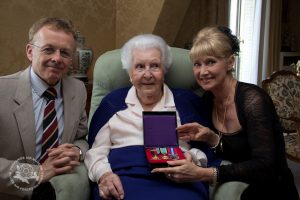
Ian Reed and Jan Leeming with René Mouchotte’s 101 year old sister Mme Jacqueline Quentin (May 2012)
With assistance from the British and French Governments a formal ceremony took place at the British Embassy in Paris where the wartime British medals were presented to the families of René Mouchotte and Henry Lafont by the British Ambassador, Sir Peter (now Lord) Ricketts, the Chief of the Air Staff, Air Chief Marshal Sir Stephen Dalton and Chief of the French Air Force, General Jean Paul Palomeros.

The Mouchotte family with René’s medals, British Embassy, Paris.
The medals are now on display at the Musée de l’Ordre de la Libération, Les Invalides, Paris.
https://www.ordredelaliberation.fr/en
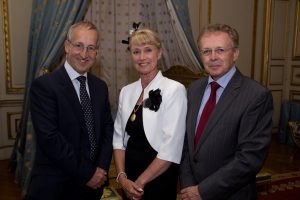
British Ambassador to France, Sir Peter Ricketts (now Lord Ricketts); Jan Leeming and Ian Reed at the medal ceremony in the Ambassador’s Residence, Paris – 13 July 2012. A further ceremony took place on 15th September 2014, when British Wartime medals were presented to the families of the other 11 French Battle of Britain pilots.
14th September 2013 the RAF Head Quarters in Gibraltar was renamed “Mouchotte Building”. Those in attendance included: ACM Sir Stuart Peach, KCB, CBE, and the Honorary French Consul in Gibraltar, Mr Pierre Fayaud. The Mouchotte Family was represented by Lt Col Hubert de Lisle (nephew to Réne by marriage).
15th September 2014
In 2014 Hubert De Lisle, Ian Reed and Vladimir Troupelin, Director of the Musée de Ordre de Liberation at the National Museum at Les Invalides, Paris, again worked together to obtain the addresses of the families of the other French fighter pilots who took part in the Battle of Britain, who also did not receive their British medals (primarily because most were killed in action). In UK, further support from the Royal Air Force Historic Branch, Ministry of Defence, UK Medal Office and the Ambassador and British Embassy in France led to another presentation on Battle of Britain Day in Paris when Air Vice Marshal Malcolm Brecht CBE presented the medals to the families of the French pilots.
15th September 2021
Two sets of British WW2 medals remained as the families could not be located, one set was kept by Ian Reed, the other by Vladimir Trouplin and after 5 years (+ COVID) the remaining two families were located and the presentation of the final set were presented by British Ambassador Mena Rawlings at a ceremony in Paris during the annual battle of Britain commemoration.

“Rue du Commandant René Mouchotte” is located adjacent to the main railway station at Montparnasse in Central Paris
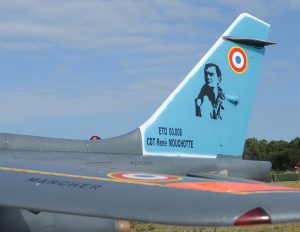
An Alphajet of the Armée de l’Air painted with the image of René Mouchotte
The Story continues……………..
Aussi en francais……………….

